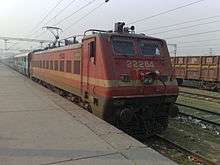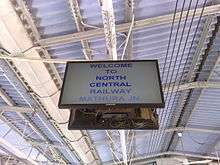Mathura Junction railway station
Mathura Junction | |
|---|---|
| Indian Railway Junction Station | |
|
| |
| Location |
Mathura, Uttar Pradesh India |
| Coordinates | 27°28′41″N 77°40′20″E / 27.4781°N 77.6722°ECoordinates: 27°28′41″N 77°40′20″E / 27.4781°N 77.6722°E |
| Elevation | 177.546 metres (582.50 ft) |
| Owned by | Indian Railways |
| Operated by | North Central Railway |
| Line(s) |
Agra-Delhi chord Delhi-Chennai line Mathura-Bharatpur-Vadodara line Mathura-Kasganj line Mathura-Achhanera line Mathura - Alwar line Mathura- Vrindavan link |
| Platforms | 09 |
| Construction | |
| Structure type | Standard on ground |
| Parking | Yes |
| Bicycle facilities | No |
| Other information | |
| Status | Functioning |
| Station code | MTJ |
| Division(s) | Agra |
| History | |
| Opened | 1904 |
| Electrified | 1982-85 |
| Previous names | East Indian Railway Company |
| Location | |
 Mathura railway station Location in Uttar Pradesh | |
Mathura | |||||||||||||||||||||||||||||||||||||||||||||||||||||||||||||||||||||||||||||||||||||||||||||||||||||||||||||||||||||||||||||||||||||||||||||||||||||||||||||||||||||||||||||||||
|---|---|---|---|---|---|---|---|---|---|---|---|---|---|---|---|---|---|---|---|---|---|---|---|---|---|---|---|---|---|---|---|---|---|---|---|---|---|---|---|---|---|---|---|---|---|---|---|---|---|---|---|---|---|---|---|---|---|---|---|---|---|---|---|---|---|---|---|---|---|---|---|---|---|---|---|---|---|---|---|---|---|---|---|---|---|---|---|---|---|---|---|---|---|---|---|---|---|---|---|---|---|---|---|---|---|---|---|---|---|---|---|---|---|---|---|---|---|---|---|---|---|---|---|---|---|---|---|---|---|---|---|---|---|---|---|---|---|---|---|---|---|---|---|---|---|---|---|---|---|---|---|---|---|---|---|---|---|---|---|---|---|---|---|---|---|---|---|---|---|---|---|---|---|---|---|---|---|
Legend
Source: Google maps | |||||||||||||||||||||||||||||||||||||||||||||||||||||||||||||||||||||||||||||||||||||||||||||||||||||||||||||||||||||||||||||||||||||||||||||||||||||||||||||||||||||||||||||||||


Mathura Junction railway station is on the Agra-Delhi chord of Delhi-Mumbai and Delhi-Chennai lines. It is located in Mathura district in the Indian state of Uttar Pradesh. It serves Mathura and Vrindavan.
Overview
Mathura is the birthplace of Lord Krishna. He spent his childhood in Vrindavan, 11 km away from Mathura. Therefore, both are major pilgrimage centres for Hindus.[1]Mathura Refinery of Indian Oil Corporation which is one of the largest oil refineries of India is located at Mathura.[2]
History
The 29 mi (47 km) long Hathras Road-Mathura Cantt line was opened in 1875 by Bombay, Baroda and Central India Railway. It was transferred to North Eastern Railway in 1952. The Mathura-Kasganj line was converted from 1,000 mm (3 ft 3 3⁄8 in) wide metre gauge to 1,676 mm (5 ft 6 in) wide broad gauge in 2009.[3][4]
The 7 mi (11 km) long metre gauge Mathura-Vrindavan branch line was opened by Bombay, Baroda and Central Indian Railway in 1889.[3]
Station
Mathura Junction has 10 Platforms. There is a junction for south bound and west bound trains. It has connectivity with all major cities of India. There are seven routes / lines from this railway junction station.[5]
Electrification
The Faridabad-Mathura-Agra section was electrified in 1982-85. The Mathura-Bharatpur line was electrified in 1985-86.[6]
Amenities
Mathura Junction railway station has a tourist information centre, telephone booths, computerised reservation centre, waiting room, vegetarian and non-vegetarian refreshment rooms, and a book stall.[7]
Passengers
Mathura Junction is amongst the top hundred booking stations of Indian Railway. The Junction is important as from here the routes of train coming from Delhi are getting bifurcated towards Mumbai and South Indian cities of Hyderabad, Bangalore and Chennai.[8]
See also
References
- ↑ "Mathura and Vrindavan – general information". ISKCON. Retrieved 2 July 2013.
- ↑ "Mathura Refinery". Indian Oil. Retrieved 2 July 2013.
- 1 2 "Indian Railways line history, 2 North Eastern Railway" (PDF). Bombay, Baroda and Central Indian Railway. wordpress. Retrieved 2 July 2013.
- ↑ "IR History:Early Days II (1870-1899)". IRFCA. Retrieved 2 July 2013.
- ↑ "Which are some of the most interesting railway stations in India?". quora.com. Retrieved 21 January 2016.
- ↑ "History of Electrification". IRFCA. Retrieved 2 July 2013.
- ↑ "Mathurapur to Bharatpur Trains". Make my trip. Retrieved 2 July 2013.
- ↑ "Indian Railways Passenger Reservation Enquiry". Availability in trains for Top 100 Booking Stations of Indian Railways. Indian Railways. Retrieved 2 July 2013.
External links
- Trains passing through Mathura Junction Railway Station
- Trains at Mathura Junction
 Mathura travel guide from Wikivoyage
Mathura travel guide from Wikivoyage Vrindavan travel guide from Wikivoyage
Vrindavan travel guide from Wikivoyage
| Preceding station | Indian Railways | Following station | ||
|---|---|---|---|---|
Baad | North Central Railway zone | |||
| Terminus | North Eastern Railway zone | |||
| Terminus | West Central Railway zone Mathura-Bharatpur line | |||
| Terminus | West Central Railway zone Mathura-Alwar line | |||
| Terminus | North Central Railway zone Mathura-Vrindavan link | Masani |
||
| Terminus | North Central Railway zone Mathura-Achhnera line | Bhainsa |